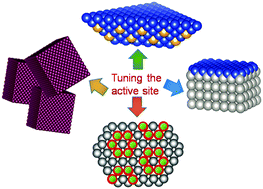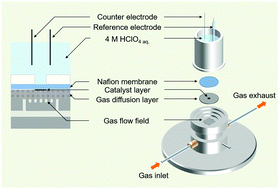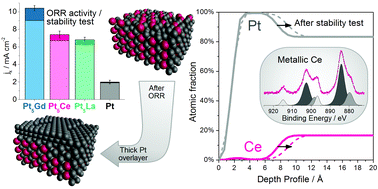Themed collection 2021 Journal of Materials Chemistry Lectureship winner: María Escudero Escribano

Tailored electrocatalysts by controlled electrochemical deposition and surface nanostructuring
Atomic representation of tailored electrocatalysts: near-surface alloy (top), shaped nanoparticles (right), atomic ensembles (bottom) and deposited metallic adlayers (left).

Chem. Commun., 2020,56, 13261-13272
https://doi.org/10.1039/D0CC06099B
Self-supported nanostructured iridium-based networks as highly active electrocatalysts for oxygen evolution in acidic media
IrOx-networks exhibit excellent catalytic activity towards oxygen evolution in acid media. A novel alternating sputtering process enabled simple and scalable fabrication of self-supported and highly dispersed iridium networks.

J. Mater. Chem. A, 2020,8, 1066-1071
https://doi.org/10.1039/C9TA12796H
Catalyst design criteria and fundamental limitations in the electrochemical synthesis of dimethyl carbonate
Electrocatalytic formation of DMC and DMO via different surface bound intermediates.

Green Chem., 2019,21, 6200-6209
https://doi.org/10.1039/C9GC02265A
Benchmarking high surface area electrocatalysts in a gas diffusion electrode: measurement of oxygen reduction activities under realistic conditions
In this work, we introduce the application of gas diffusion electrodes (GDE) for benchmarking the electrocatalytic performance of high surface area fuel cell catalysts.

Energy Environ. Sci., 2018,11, 988-994
https://doi.org/10.1039/C8EE00019K
Towards the elucidation of the high oxygen electroreduction activity of PtxY: surface science and electrochemical studies of Y/Pt(111)
Insight into the high oxygen electroreduction activity of PtxY by studying single crystal Y/Pt(111).

Phys. Chem. Chem. Phys., 2014,16, 13718-13725
https://doi.org/10.1039/C4CP00319E
Enhanced activity and stability of Pt–La and Pt–Ce alloys for oxygen electroreduction: the elucidation of the active surface phase
Three different Pt–lanthanide metal alloys (Pt5La, Pt5Ce and Pt3La) have been studied as oxygen reduction reaction (ORR) electrocatalysts.

J. Mater. Chem. A, 2014,2, 4234-4243
https://doi.org/10.1039/C3TA14574C
Electrochemical and FTIRS characterisation of NO adlayers on cyanide -modified Pt(111) electrodes : the mechanism of nitric oxide electroreduction on Pt
The availability of adsorbed hydrogen determines if the reductive stripping of NO irreversibly adsorbed on platinum proceeds through an Eley–Rideal or a Langmuir–Hinshelwood mechanism.

Phys. Chem. Chem. Phys., 2008,10, 3628-3634
https://doi.org/10.1039/B717396B
About this collection
The Journal of Materials Chemistry annual lectureship, established in 2010, honours early-career scientists who have made a significant contribution to the field of materials chemistry.
The Lectureship recipient receives expenses to cover travel and accommodation costs to attend and present at a leading international meeting. The recipient is also invited to contribute an article to one of the Journal of Materials Chemistry journals and to receive a complimentary back cover for the issue in which the article appears.
María Escudero Escribano is an Associate Professor of Chemistry at the University of Copenhagen, where her group investigates tailored interfaces and electrocatalyst materials for renewable energy conversion and electrosynthesis of green fuels and value-added chemicals. She graduated in Chemical Engineering from the University of Extremadura and obtained her Ph.D. in Chemistry from the Autonomous University of Madrid in 2011. She then started her postdoctoral research at the Technical University of Denmark and was a 'DFF: Sapere Aude Research Talent' fellow at Stanford University, before moving to the University of Copenhagen in 2017. María is a ‘Villum Young Investigator’ (2018-2023) and co-PI of the Center for High Entropy Alloy Catalysis. Her work combines the insight from model studies on well-defined electrochemical interfaces with real systems and advanced materials for catalysis and renewable energy applications. María is a co-inventor of three patents on novel catalyst materials for electrochemical energy conversion. In addition to her regular invited, plenary and keynote lectures at international conferences and invited seminars at universities, she is highly involved in scientific outreach and dissemination activities.
María has received numerous awards at international and national levels in recognition of her groundbreaking research. These awards include the European Young Chemist Award 2016 (Gold Medal) from EuChemS, the Princess of Girona Foundation Scientific Research Award 2018, the Electrochemical Society Energy Technology Division Supramaniam Srinivasan Young Investigator Award 2018, the Spanish Royal Society of Chemistry Young Researchers Award 2019, and the Clara Immerwahr Award 2019.